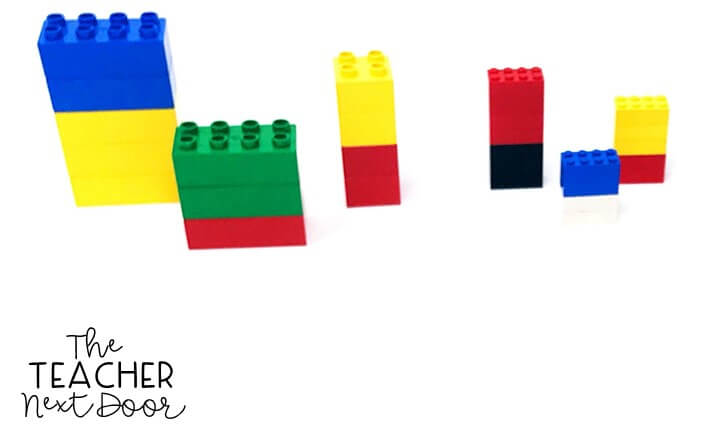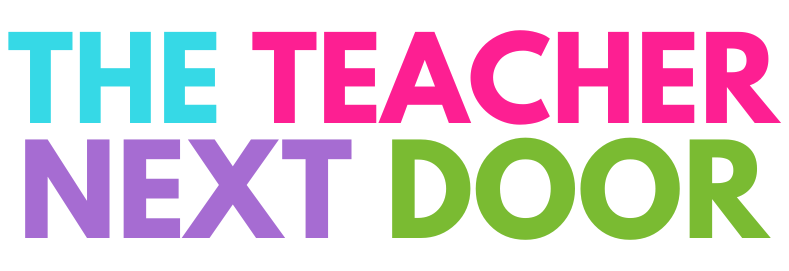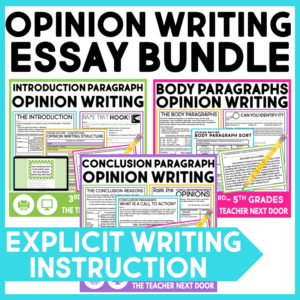
Fractions can be tough! While it takes time and repeated exposure with fractions for students to have a real understanding of them, there are lots of experiences and activities we can provide as teachers to move their understanding along!
In this post, I’ll share a few of my favorite fraction activities with you!
1. Fractions You Can Touch…And Some You Can Eat!
The first thing we want to do is to provide lots of no pressure, opportunities to play work with objects to make the concept of fractions more clear. Play-Doh is a great way to make fractions!
Of course, you’ll need to let kids play with the Play-Doh on their own at first, but after a few minutes, you can work together to make fraction cookies or fraction pizzas which are cut into equal parts, like halves, thirds, or fourths.
Depending upon your school’s food regulations, a handful (or a bite-sized package) of M&M’s or Skittles are great to sort into colors and to label each color as a fraction. The total number of candies would be the denominator and the numerator would be the specific color of candies in that group.
Colored marshmallows or cereal with several different shapes (like Lucky Charms) also work well. I do let students eat them at the end of the lesson after their fraction page has been spot-checked by myself.

Trying to stay away from food items?
There are lots of small items that work equally well. Buttons in different colors, mini-erasers (great way to use these), small plastic animals, wooden tangram shapes, and so on make perfect fraction examples!

2. Mentor Texts
There are some really great picture books that either are meant to use to teach fractions, or which have some themes in the books which lend themselves to a discussion about fractions. Check out the picture above for some of my favorite mentor texts if you’d like to add some reading to math time.
3. Fractions in a Cup
To play this game, place your students in pairs. Give each pair a plastic cup with some two-sided counters (your choice of how many counters depending upon your students’ abilities). Students gently shake the cup and pour the contents out carefully, so the pieces don’t fly everywhere. Then students write two fractions to describe what they see.
For example, if there were seven counters total and four landed on the yellow side, that fraction is 4/7. That would mean that there would also be 3/7 red counters facing up for a total of 7/7, which is all of the counters.
If you want to make this into a game, each student could choose one of the colors. After students have written their fractions on whiteboards, have one student flip a More/Less Coin, which is simply a plastic counter with More on one side and Less on the other side on either a sticker or written in sharpie.
The student who has the largest fraction wins if More is flipped and the student who has the smaller fraction wins if Less is shown. This keeps students motivated to play even if the other student has a fraction which is obviously larger.

4. LEGOS or DUPLOS
LEGOS or DUPLOS blocks are great visual tools when teaching fractions. Although these can be expensive, you might be able to borrow some or get some donated from friends with children who have outgrown them.
If you only have a small amount, these work well for a guided math activity. Ask kids to show you certain fractions (like 1/3 or 2/5) and kids get practice making fractions as they build them. If you have lots of LEGOS, this could be done as a whole class lesson.
To use LEGOS or DUPLOS as a center game, you can put kids in groups of two. Each child rolls the dice twice, to determine the numbers in the fraction. The smaller number rolled is the numerator and the larger number is the denominator.
Kids use LEGOS to create that fraction using two different colors. For example, if a child rolled a 2 and a 5, the fraction is 2/5 and a tower could be made with two red LEGOS and three blue LEGOS for a total of five LEGOS.
After both students have built their fraction towers, use the More/Less Coin to determine the winner, who keeps the cards.

5. Playing Cards for Comparing Fractions
This is a game for two players. First, take out all of the face cards but leave the Aces, which will be used as ones. Students shuffle the cards and place them face down.
Each student chooses two cards and places them with the smaller card for the numerator and the larger card for the denominator. Students compare fractions by finding the common denominator.
Once the larger and smaller fractions are determined, I have students use the More/Less Coin described above to determine the winner. The winner keeps the cards and the person with the most cards at the end of the game wins.
6. Fraction Task Cards and Games
One of my favorite ways to reinforce math concepts is to use math task cards and games. Kids really enjoy playing in a game format and I can target the specific types of concepts and standards we need to practice. If you’re looking for pre-made task card sets for fractions, I have quite a few of them you might like.
Click here for the 3rd Grade Fractions Bundle.
Here’s the 4th Grade Fractions Bundle.
This is the 5th Grade Fractions Bundle.

7. Fractions About Us
I like to start this activity by doing a whole class lesson. I ask students different questions and we make fractions on our whiteboards based on the answers.
For example, if there are 28 students and I ask how many kids like popcorn, we might get a fraction like 27/28 kids like popcorn.
Or I’ll ask how many kids have brothers, walk to school, play basketball, like broccoli, etc. We make fractions for each one.
Then to switch it up a bit, I pull a group of four kids to the front and only ask them a question, which changes the denominator. Then I have them sit down and pull a group of six kids to the front to do another question. Again, reinforcing that the total number in the group is the denominator.
Once we’ve done that introduction, I put kids into groups of about five and give them a large piece of construction paper or a piece of anchor chart paper.
First, each child writes his/her name on the poster. Then, each child takes turns asking a question and recording the group’s answers in fraction form. Once everyone has had a chance to survey their group once or twice, it’s fun to let the kids do a Gallery Walk to see everyone else’s posters.
8. Domino Games
A. Compare Fractions
For this game, students place all of the dominoes face down. Each child chooses one domino and turns it so the numerator is smaller than the denominator. Using common denominators, students determine which fraction is smaller and larger. A More/Less Coin is used to determine the winner, who keeps the domino.

B. Equivalent Fractions
All of the dominoes are placed face down. Each student chooses a domino and on a whiteboard or scratch piece of paper, tries to write an equivalent fraction for that domino. For example, 2/3 = 4/6, or 8/12, or 16/24. To make it a game, each person who writes at least three equivalent fractions may keep their domino.

C. Improper Fractions
All of the dominoes are placed face down. Each student chooses a domino and places it with the larger number on top as the numerator and the smaller number as the denominator. This will make an improper fraction. Each student changes the improper fraction to a mixed number. Once done, use a More/Less Coin to determine who wins that round.
Lastly, if you’d like a Math Task Card Bundle with 30 Sets of task cards, one for EVERY STANDARD, you might like to take a look at these:
3rd Grade Math Task Cards Bundle

4th Grade Math Task Cards Bundle

5th Grade Math Task Cards Bundle

Thanks so much for stopping by!















![DAY THREE DROPS! ⬇️⬇️⬇️
👉 Today, you can…
✔️ Grab done-for-you resources to keep your students engaged for $3
✔️ Grab FREE instant download activities!
✔️ Grab all of this week’s deals if you missed any!
ALL 5 of these comprehensive resources from my shop are $3 today to help fight spring fever in your classroom! 🌸🌼🌷
✏️ [BRAND NEW] Step-By-Step Personal Narrative Unit
✏️ Paired Texts Fiction to Nonfiction for Spring
✏️ 4th Grade Morphology & Vocabulary Unit
✏️ Main Idea Unit for 4th & 5th Grades
✏️ Figurative Language Complete Unit for Busy Teachers
Want the link to all the deals and freebies? Comment APRIL PARTY and we’ll send it directly to your DMs! 📫💌
PS - Don’t forget that you can still access all the Day 1 and Day 2 Deals too! 🩷](https://the-teacher-next-door.com/wp-content/plugins/instagram-feed/img/placeholder.png)

